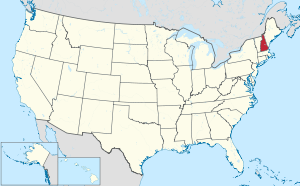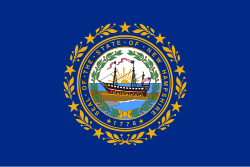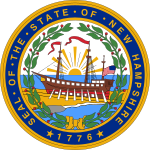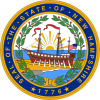
- Details
- Written by Super User
- Category: New Hampshire
- Hits: 3873
Jump to navigationJump to search
|
New Hampshire
|
|
|---|---|
| State of New Hampshire | |
| Nickname(s): | |
| Motto(s): | |
| Anthem: "Old New Hampshire"[3] | |

Map of the United States with New Hampshire highlighted
|
|
| Country | United States |
| Before statehood | Province of New Hampshire |
| Admitted to the Union | June 21, 1788 (9th) |
| Capital | Concord |
| Largest city | Manchester |
| Largest metro and urban areas | Greater Boston (combined and metro) Nashua (urban) |
| Government
|
|
| • Governor | Chris Sununu (R) |
| • Senate President | Chuck Morse (R)[4] |
| Legislature | General Court |
| • Upper house | Senate |
| • Lower house | House of Representatives |
| Judiciary | New Hampshire Supreme Court |
| U.S. senators | Jeanne Shaheen (D) Maggie Hassan (D) |
| U.S. House delegation | 1: Chris Pappas (D) 2: Ann McLane Kuster (D) (list) |
| Area
|
|
| • Total | 9,349 sq mi (24,214[5] km2) |
| • Rank | 46th |
| Dimensions
|
|
| • Length | 190 mi (305 km) |
| • Width | 68 mi (110 km) |
| Elevation
|
1,000 ft (300 m) |
| Highest elevation | 6,288 ft (1,916.66 m) |
| Lowest elevation
(Atlantic Ocean[7])
|
0 ft (0 m) |
| Population
(2020)
|
|
| • Total | 1,377,529 |
| • Rank | 41st |
| • Density | 147.3/sq mi (56.9/km2) |
| • Rank | 21st |
| • Median household income
|
$73,381[8] |
| • Income rank
|
8th |
| Demonym(s) | Granite Stater, New Hampshirite |
| Language
|
|
| • Official language | English[9] (French allowed for official business with Quebec)[10] |
| Time zone | UTC−05:00 (Eastern) |
| • Summer (DST) | UTC−04:00 (EDT) |
| USPS abbreviation |
NH
|
| ISO 3166 code | US-NH |
| Traditional abbreviation | N.H. |
| Latitude | 42° 42′ N to 45° 18′ N |
| Longitude | 70° 36′ W to 72° 33′ W |
| Website | www |
| hideNew Hampshire state symbols | |
|---|---|

|
|
 |
|
| Living insignia | |
| Amphibian | Red-spotted newt Notophthalmus viridescens |
| Bird | Purple finch Haemorhous purpureus |
| Butterfly | Karner Blue Lycaeides melissa samuelis |
| Dog breed | Chinook |
| Fish | Freshwater: Brook trout Salvelinus fontinalis Saltwater: Striped bass Morone saxatilis |
| Flower | Purple lilac Syringa vulgaris |
| Insect | Ladybug Coccinellidae |
| Mammal | White-tailed deer Odocoileus virginianus |
| Tree | White birch Betula papyrifera |
| Inanimate insignia | |
| Food | Fruit: Pumpkin Vegetable: White Potato Berry: Blackberry[11] |
| Gemstone | Smoky quartz |
| Mineral | Beryl |
| Rock | Granite |
| Sport | Skiing |
| Tartan | New Hampshire state tartan |
| State route marker | |
 |
|
| State quarter | |

Released in 2000
|
|
| Lists of United States state symbols | |
New Hampshire is a state in the New England region of the United States. It is bordered by Massachusetts to the south, Vermont to the west, Maine and the Gulf of Maine to the east, and the Canadian province of Quebec to the north. Of the 50 U.S. states, New Hampshire is the fifth smallest by area and the tenth least populous, with slightly more than 1.3 million residents. Concord is the state capital, while Manchester is the largest city. New Hampshire's motto, "Live Free or Die", reflects its role in the American Revolutionary War; its nickname, "The Granite State", refers to its extensive granite formations and quarries.[12] It is best known nationwide for holding the first primary (after the Iowa caucus) in the U.S. presidential election cycle.[13]
New Hampshire was inhabited for thousands of years by Algonquian-speaking peoples such as the Abenaki. Europeans arrived in the early 17th century, with the English establishing some of the earliest non-indigenous settlements. The Province of New Hampshire was established in 1629, named after the English county of Hampshire.[14] Following mounting tensions between the British colonies and the crown during the 1760s, New Hampshire saw one of the earliest overt acts of rebellion, with the seizing of Fort William and Mary from the British in 1774. In January 1776, it became the first of the British North American colonies to establish an independent government and state constitution; six months later, it signed the United States Declaration of Independence and contributed troops, ships, and supplies in the war against Britain. In June 1788, it was the ninth state to ratify the U.S. Constitution, bringing that document into effect.
Through the mid-19th century, New Hampshire was an active center of abolitionism, and fielded close to 32,000 men for the Union during the U.S. Civil War. After the war, the state saw rapid industrialization and population growth, becoming a center of textile manufacturing, shoemaking, and papermaking; the Amoskeag Manufacturing Company in Manchester was at one time the largest cotton textile plant in the world. The Merrimack and Connecticut rivers were lined with industrial mills, most of which employed workers from Canada and Europe; French Canadians formed the most significant influx of immigrants, and today roughly a quarter of all New Hampshire residents claim French American ancestry, second only to Maine.
Reflecting a nationwide trend, New Hampshire's industrial sector declined after the Second World War. Since 1950, its economy has heavily diversified to include financial and professional services, real estate, education, and transportation, with manufacturing still higher than the national average.[15] Beginning in the 1980s, its population surged as major highways connected it to the Greater Boston and led to more bedroom communities. In the 21st century, New Hampshire is among the wealthiest states in the U.S., with the seventh-highest median household income and some of the lowest rates of poverty, unemployment, and crime. It is one of only nine states without an income tax, and has no taxes on sales, capital gains, or inheritance; consequently, its overall tax burden is the lowest in the U.S. after Florida. New Hampshire ranks among the top ten states in metrics such as governance, healthcare, socioeconomic opportunity, and fiscal stability.[16][17]
With its mountainous and heavily forested terrain, New Hampshire has a growing tourism sector centered on outdoor recreation. It has some of the highest ski mountains on the East Coast and is a major destination for winter sports; Mount Monadnock is among the most climbed mountains in the U.S. Other activities include observing the fall foliage, summer cottages along many lakes and the seacoast, motorsports at the New Hampshire Motor Speedway, and Motorcycle Week, a popular motorcycle rally held in Weirs Beach in Laconia. The White Mountain National Forest links the Vermont and Maine portions of the Appalachian Trail, and has the Mount Washington Auto Road, where visitors may drive to the top of 6,288-foot (1,917 m) Mount Washington.


